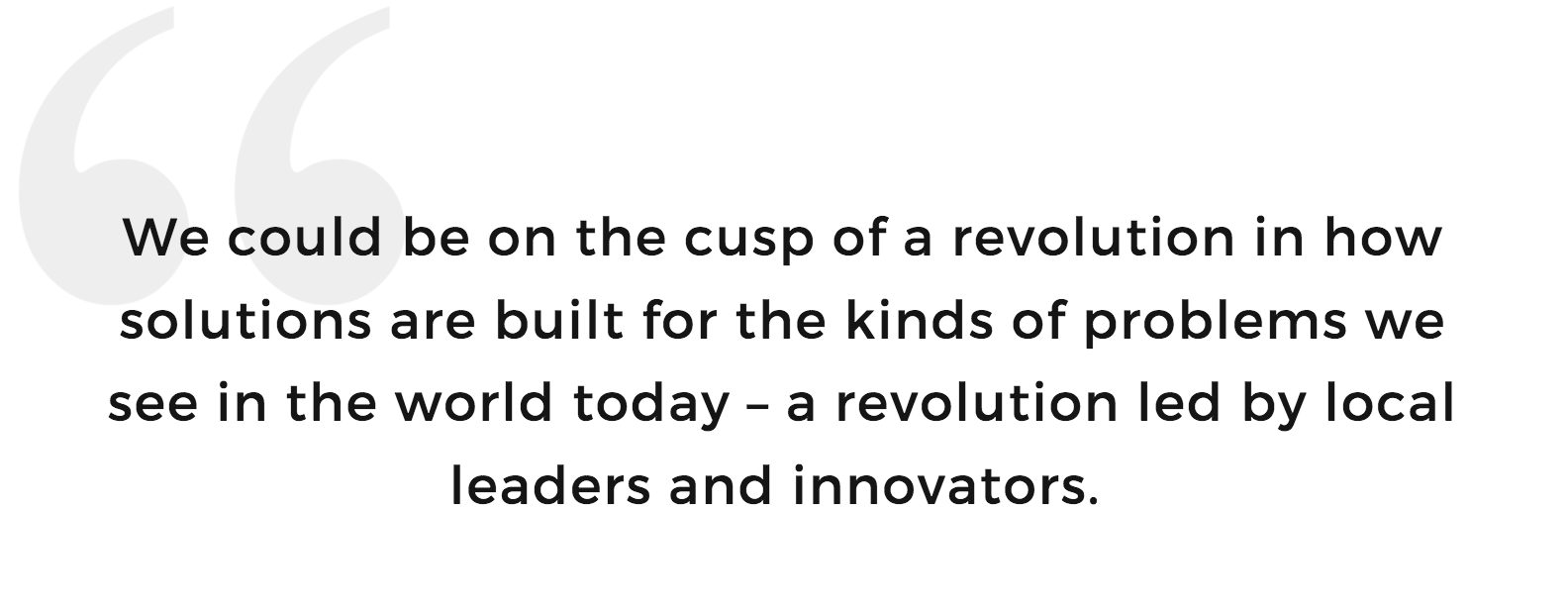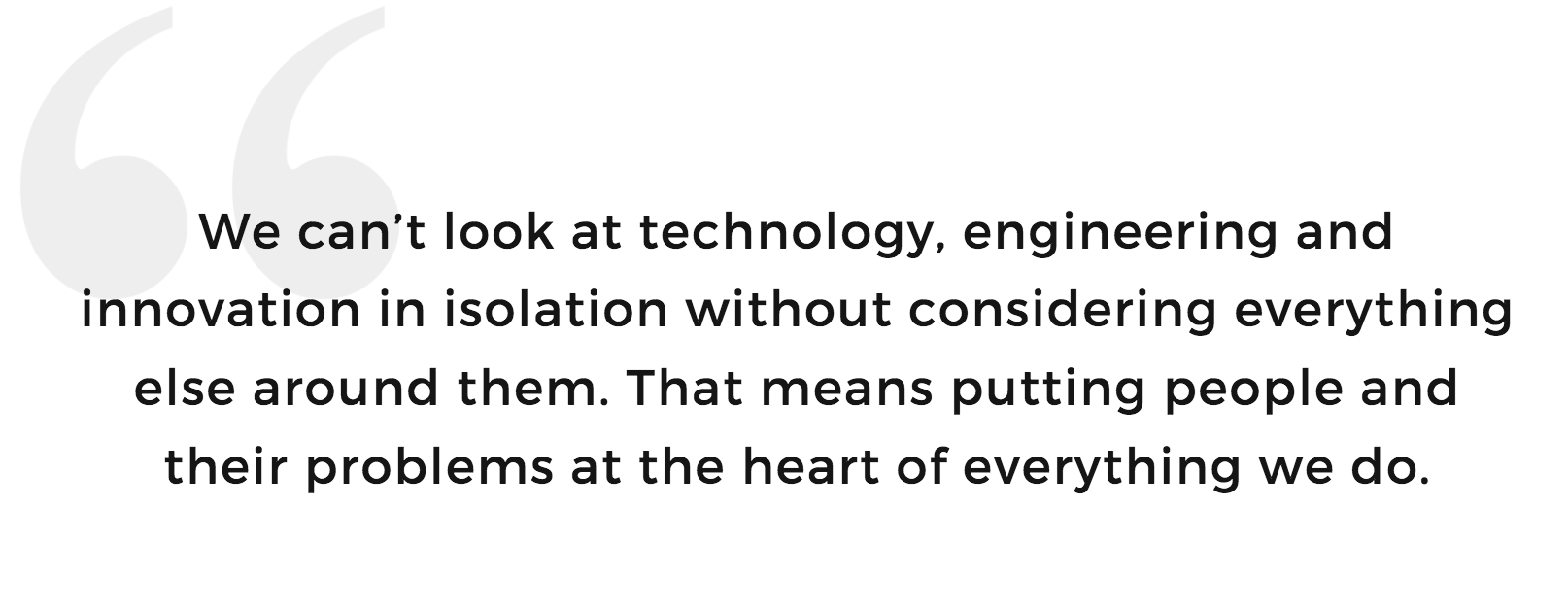 or much of the past 25 years, I’ve dedicated my time to figuring out how mobile technology might help support positive social and environmental change in the developing world. During that time, I created FrontlineSMS, an open source software for grassroots organizations to distribute and collect information via text messages, and it was built from the ground up to reach global scale. Along the way, I spent time living and working in many communities where I both led and witnessed development projects firsthand. I’ve seen attempts at innovation go well, and I’ve seen others crash and burn.
or much of the past 25 years, I’ve dedicated my time to figuring out how mobile technology might help support positive social and environmental change in the developing world. During that time, I created FrontlineSMS, an open source software for grassroots organizations to distribute and collect information via text messages, and it was built from the ground up to reach global scale. Along the way, I spent time living and working in many communities where I both led and witnessed development projects firsthand. I’ve seen attempts at innovation go well, and I’ve seen others crash and burn.
In its Sustainable Development Goals (SDG) Agenda for 2030, the United Nations recognizes the importance of building resilient infrastructure and fostering innovation. The vast majority of my work over the years falls under the umbrella of this particular SDG. However, my entry point comes not from technology, but rather from the intersection of anthropology, development and conservation.
In fact, the most important thing I’ve learned over the years is not how to implement a technology; it’s that you need to spend time with real people to understand their real needs. Too often in the development sector, I still see this critical step overlooked. In human development, assumptions are dangerous. If we’re going to make progress toward this SDG by 2030, then we need to slow down, drop our innovation fetish, and lead first with the people and the problem.
Building Appropriate Technology
To seriously tackle the problems we face as a society at scale – such as the billions of people without access to financial services or who live far away from medical facilities – we’re likely going to need to adopt some form of technology. We simply won’t reach the numbers we need if we don’t. It’s also fair to say that it’ll be hard to meet almost all the other SDGs if we don’t focus on innovative engineering and problem solving to some degree.
But while it’s encouraging to see an acknowledgement of the role of technology and innovation, one critical word is missing in the description of this SDG – and that’s “appropriate.”
For me, this is an unfortunate oversight. Everybody seems to love the word ‘innovation,’ and people like to emphasize everything digital. It’s all about exciting, new and sexy, and it’s celebrated in the Western world with prizes, challenges and fame in the press for those who make the most noise. Sadly, the vast majority of technological innovations serve only a minority of people, who often live in the West. For reasons of cost, access – and yes, appropriateness – most technologies just don’t work in settings much different from those where they were designed.
 Although FrontlineSMS was designed, built and launched in a matter of months, it was not an overnight success story. The secret to it working came from experiences I had gained over 12 years living and working with people, and studying what life was like for those it was built to help – with much of that time spent in the field. Without that intimate knowledge, I don’t believe I would have been able to build something that ended up working so well for them.
Although FrontlineSMS was designed, built and launched in a matter of months, it was not an overnight success story. The secret to it working came from experiences I had gained over 12 years living and working with people, and studying what life was like for those it was built to help – with much of that time spent in the field. Without that intimate knowledge, I don’t believe I would have been able to build something that ended up working so well for them.
I had also seen too many development projects come in and bulldoze their way through local ideas and knowledge, and that wasn’t a mistake I was going to make. Instead, my solution was built on trust in the users and faith that they knew how to best solve their own problems – or at least more than an English guy who lived several thousand miles away. I also wanted them to own their solution.
There really is no shortcut to spending time in the field and spending time understanding people and their needs.
What Happens When Innovation Works
We live in an exciting time, and opportunities are endless if we slow down and think about what it is we’re trying to do. Here’s just a few of the things that excite me.
First, it’s now possible to bypass the charity sector and send direct payments from our mobile phones in Boulder, Paris or London directly to the handset of a farmer in Uganda, Zimbabwe or Zambia. This represents huge potential for disruption in how aid is delivered, especially after devastating natural disasters. Again, it’s about trust, but also about efficiency. If we give people cash, and not food aid for example, do they spend it wisely? Can we save money and give them more by cutting out aid bureaucracy? So far, the evidence points to yes, and we’re only at the beginning.
Second, mobile technology has enabled us to leapfrog infrastructure challenges in places where bricks and mortar financial institutions don’t exist (and there are many). Now, people can transfer or save money, take out insurance, put money aside for their futures, or make payments without traveling large distances, all through their phones. For anyone who has seen what a struggle making payments used to be, this is huge.
Third, smart phones are becoming increasingly widespread in emerging markets. We’re still a long way off from finding them in sufficient numbers in the places they need to be, but in 10 years it’s possible that most people who have a phone will have one that connects to the Internet. This is another opportunity to build and deliver solutions to pressing needs, but also to allow people to solve their own problems.
 The final thing that excites me is the increasing numbers of home grown software developers, engineers, technologists and innovators using digital technology to build solutions in the communities and villages where they grew up. Problem solvers and solutions developers are no longer just people coming in from the outside. Across Africa, we’re seeing talented programmers with intimate knowledge of their country’s problems graduate with computer science degrees and go into the business and social sectors. We’ve never had a better opportunity to solve some of these problems than we do today, and it will only improve.
The final thing that excites me is the increasing numbers of home grown software developers, engineers, technologists and innovators using digital technology to build solutions in the communities and villages where they grew up. Problem solvers and solutions developers are no longer just people coming in from the outside. Across Africa, we’re seeing talented programmers with intimate knowledge of their country’s problems graduate with computer science degrees and go into the business and social sectors. We’ve never had a better opportunity to solve some of these problems than we do today, and it will only improve.
In summary, for me it feels like we have a perfect storm brewing. We could be on the cusp of a revolution in how solutions are built for the kinds of problems we see in the world today – a revolution led by local leaders and innovators. The existing model has been broken for some time, and we finally have something to replace it.
The Dark Side of Innovation
Despite all the positive things innovation can do for us, there is a flip side. The first, which I mentioned earlier, is that we have a habit of building inappropriate solutions that don’t scale, or are difficult to scale. When we think about developing digital solutions, we need to remember that many people still don’t have a phone, or access to the Internet. Without a smart phone and a connection, how are people going to use your app, however innovative or groundbreaking it is? The irony is that more often than not, older and less sexy – but well-tested – solutions may be better for some communities.
Another danger is that we’re developing a growing dependency on technology. We all know how difficult it is to do anything when our Internet connection goes down, when we lose power, or when an airline’s booking system fails. While technology seamlessly streamlines things and increases their efficiency and reach, things collapse when it breaks. Imagine a world where we got rid of physical cash and only had digital payments – how would we buy anything if the technology crashes? Today, if we go to the store and our credit card doesn’t work, we can usually dig out a little cash. In these circumstances, we have a Plan B. What’s our bigger Plan B?
 We’re building a world that runs on technology, yet we know full well the chaos that ensues when that technology fails. I often feel I’m giving out contradictory messages – promoting technology use on one hand, but preaching the dangers on the other. But I know I can’t sit here and say not to build anything that uses technology because one day it might break. Progress doesn’t work that way. Perhaps what I would say is think about what might happen – and what your users would do – when it does.
We’re building a world that runs on technology, yet we know full well the chaos that ensues when that technology fails. I often feel I’m giving out contradictory messages – promoting technology use on one hand, but preaching the dangers on the other. But I know I can’t sit here and say not to build anything that uses technology because one day it might break. Progress doesn’t work that way. Perhaps what I would say is think about what might happen – and what your users would do – when it does.
Fortunately, many of us live in places where it’s easy to get things fixed. But that can’t be said for a rural farmer in Zambia. Mitigating this danger takes me back to my starting point of creating appropriate technologies that can be maintained, supported and repaired locally wherever possible. Supporting innovation hubs can foster a strong sense of local ownership, and today there are plenty of these.
Moving from Vanity to Value
On our current trajectory, I’m not overly optimistic that we’ll achieve Goal #9 by 2030. I still see far too much wasted effort going into building or funding the wrong things, often for the wrong reasons, and far too much duplication of effort.
At almost every conference these days, you’ll see someone tweet that we need to “stop reinventing the wheel.” Yet nearly every week some new ‘innovation challenge’ seems to launch, asking people to submit their ideas on how to solve education in refugee camps, or access to healthcare in the last mile. There’s this unproven belief that the wisdom of the crowd will solve all our development challenges, but what does the average person living in the U.S. or U.K. know about refugee camps in Syria? In many cases, people have been working on these issues for decades. Their solutions may not be perfect, but why can’t we build on their efforts? The message these innovation challenges give are that none of the solutions we currently have work, and that we desperately need new ones. That couldn’t be further from the truth.
We can’t, and shouldn’t, look at technology, engineering and innovation in isolation without considering everything else around them, and that means putting people and their problems at the heart of everything we do. We should constantly keep our eyes on the bigger prize – the alleviation of human suffering – and remember who we’re doing this work for.
We are custodians of this opportunity, and it’s down to us to make the most of it.



